THIS week we have another 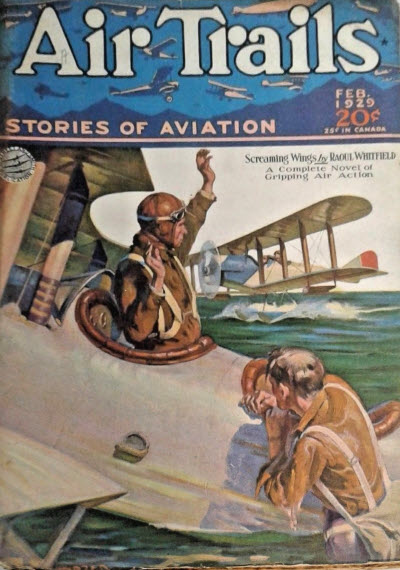 exciting air adventure with Rusty Wade from the pen of Frank Richardson Pierce. Pierce is probably best remembered for his prolific career in the Western Pulps. Writing under his own name as well as two pen names—Erle Stanly Pierce and Seth Ranger—Pierce’s career spanned fifty years and produced over 1,500 short stories, with over a thousand of these appearing in the pages of Argosy and the Saturday Evening Post.
exciting air adventure with Rusty Wade from the pen of Frank Richardson Pierce. Pierce is probably best remembered for his prolific career in the Western Pulps. Writing under his own name as well as two pen names—Erle Stanly Pierce and Seth Ranger—Pierce’s career spanned fifty years and produced over 1,500 short stories, with over a thousand of these appearing in the pages of Argosy and the Saturday Evening Post.
This time around, gold has been found at an old claim up north and Rusty’s in a race with an unscrupulous pilot to reach the site and stake the claim and get back first to register said claim. Can Rusty outwit and outfly Pratt and get Old Man Dorsey back to the registrar’s off first. From the pages of the February 1929 Air Trails, it’s Frank Richardson Pierce’s “Mushing Down the Air Trail!”
High-powered planes and battling pilots above the snow fields of Alaska!
And as a bonus, here’s “The Landing Field” column from the January 1930 number of Air Trails where we get to know more about Frank Richardson Pierce, Rusty Wade, Alaska and the Air Musher!
THE LANDING FIELD
AIR TRAILS • January 1930 v3n4
IN THESE crisp 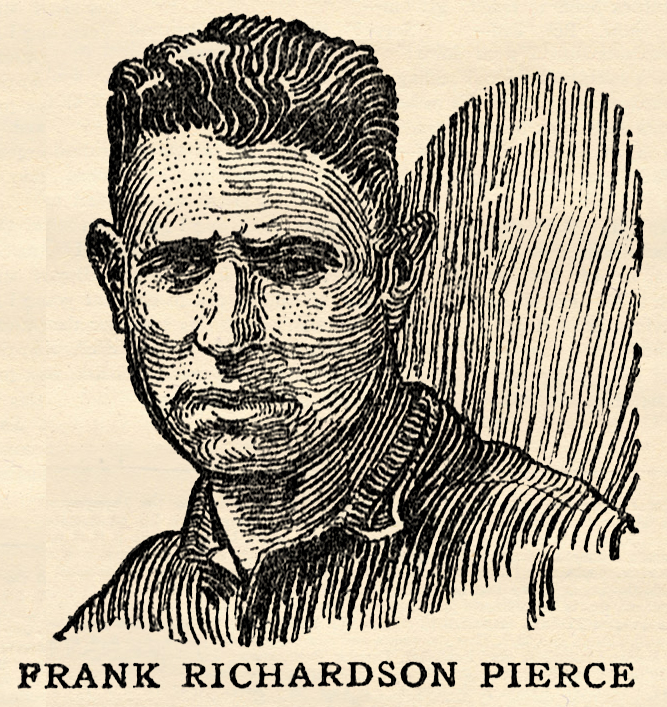 winter days with snow streaking through the sky, it seems right and proper to introduce Frank Richardson Pierce to you folks. Pierce lives up in the Northwest, up in Seattle, Washington—and he spends a good deal of his time hopping around Alaska. He is an outdoor man in every sense of the word. There are few writers in America who can catch the spirit of the frozen North as he can. His interests lie out under the open sky, with snow fields, fir forests, Canyons and great rivers. It was natural, therefore, that he took to flying.
winter days with snow streaking through the sky, it seems right and proper to introduce Frank Richardson Pierce to you folks. Pierce lives up in the Northwest, up in Seattle, Washington—and he spends a good deal of his time hopping around Alaska. He is an outdoor man in every sense of the word. There are few writers in America who can catch the spirit of the frozen North as he can. His interests lie out under the open sky, with snow fields, fir forests, Canyons and great rivers. It was natural, therefore, that he took to flying.
For the past year you’ve been reading the “Rusty†Wade stories by Pierce. They’ve made a hit with Air Trails readers all over the country. The reason is that they ring as true as the roar of a Whirlwind motor on the nose of a new sport model ship. Pierce knows all about the Rusty Wade country.
He just recently came back from a trip over Alaska. Here’s what he says: “I get a great kick out of flying over some place I’ve walked. It gives me a chance to laugh at myself in comfort. But mostly I prefer flying in Alaska—the walking is tougher there.
“Alaskans lead the nation in air-mindedness. They have been flying for years—not for sport, but for business reasons. Why should a miner pole a boat for days up a river and fight mountains and glaciers when he can fly there with his outfit for a few dollars and still have the whole season ahead of him in which to prospect? Where in previous years it required weeks and months to bring out a load of fur, now it comes out in hours.
“An Eskimo may be popeyed when he arrives in Seattle and sees street cars, automobiles and skyscrapers, but he’ll not even blink at an airplane. He’s seen them before and probably has ridden in one.
“Rusty Wade is a typical Alaskan pilot. Landing fields are few and far between. If a pilot is forced down he has to walk out and it may take him days. And yet, right now, I can’t recall a single crash in which any one was killed. There may have been some, you understand, but I can’t recall them.
“At times, in Rusty Wade stories, I have tried to describe Alaska from the air. Thus far I have failed utterly. I doubt if there is in the whole world, anything more beautiful than flying over ice fields and glaciers studded with mighty peaks and set with lakes of the rarest blue. If any of the readers make a trip next summer, cable ahead to Juneau and make arrangements to see a bit of Alaska from the air while the steamer is lying over.
“At the present time a surveying party is working out of Juneau in planes. They are surveying a waterpower project discovered by the Alaskan air-mappers—a navy outfit. The lake is two thousand three hundred feet above the sea in a rough country. It would take many hours of the hardest work to reach the spot with equipment. The plane leaves Juneau and is on the lake within twenty minutes. It has even taken up a fourteen-foot skiff to the lake.â€
A NUMBER of readers have written in, wanting to know what type of plane the Air Musher that Rusty Wade uses is. Well, that’s easy, and it gives us a chance to do a little “ground flying†here in front of the hangars. There’s nothing that a pilot likes so much as to talk about different types of ships.

The Air Musher is a Fokker Universal Monoplane equipped with ski landing gear. It is a type of plane that has stood the test of time. Ask any flyer what he thinks about the Fokker Universal. It has been used for prospecting, forest fire patrol, exploring, crop dusting, and for mail and passenger transportation on most of the air routes of this country and Canada.
With a pilot, four passengers and eighty pounds of mail or baggage, the Fokker Universal can carry enough gas to cruise for six hundred miles. It is generally powered with a Whirlwind motor, and, carrying a fair load, can reach a ceiling of sixteen thousand feet. Fully loaded, the landing speed is forty-five miles per hour and the high speed one hundred and eighteen m.p.h. One of the good things about this crate is the perfect vision provided for the pilot. He sits ahead of the leading edge of the wing and can look forward, right, left, overhead and downward. This is a big feature when you have to set down in rough Alaska country, where landing fields are not made to order.
The Fokker Universal will almost never spin or nose dive when stalled. It glides downward on an even keel while remaining under full control. With its wings of semi-cantilever construction and its strong cabin the Fokker Universal is just the type of ship for work in rough country where flights are made in all kinds of weather. There are bigger ships, more powerful ones, and faster ones; but there are few that can stand up under all conditions like the type of which Rusty’s Air Musher is representative.
If the Air Musher ever cracks up against the side of a glacier, Rusty Wade will probably be getting one of the Fokker Super-Universals to take its place. They are slightly larger ships, with a wing span of fifty feet seven inches, and powered with a Pratt & Whitney four hundred h.p. motor. They can carry as many as eight passengers, and, with a fair load, can reach a service ceiling of eighteen thousand feet. Their top speed is one hundred and thirty-eight miles per hour.
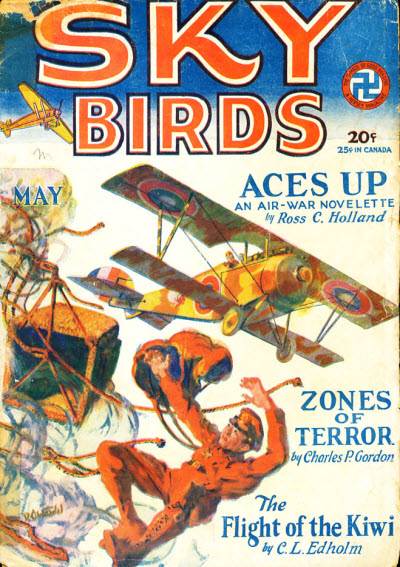 another story from one of the new flight of authors on the site this year—Andrew A. Caffrey. Caffrey, who was in the American Air Service in France during The Great War and worked for the air mail service upon his return, was a prolific author of aviation and adventure stories for both the pulps and slicks from the 1920’s through 1950. Here Caffrey tells the tale of Loop Murry, stunt flier for the movies who learns there’s sometime more to a man than meets the eye. From the May 1929 number of Sky Birds, it’s Andrew A. Caffrey’s “The Vanishing Ace!”
another story from one of the new flight of authors on the site this year—Andrew A. Caffrey. Caffrey, who was in the American Air Service in France during The Great War and worked for the air mail service upon his return, was a prolific author of aviation and adventure stories for both the pulps and slicks from the 1920’s through 1950. Here Caffrey tells the tale of Loop Murry, stunt flier for the movies who learns there’s sometime more to a man than meets the eye. From the May 1929 number of Sky Birds, it’s Andrew A. Caffrey’s “The Vanishing Ace!”




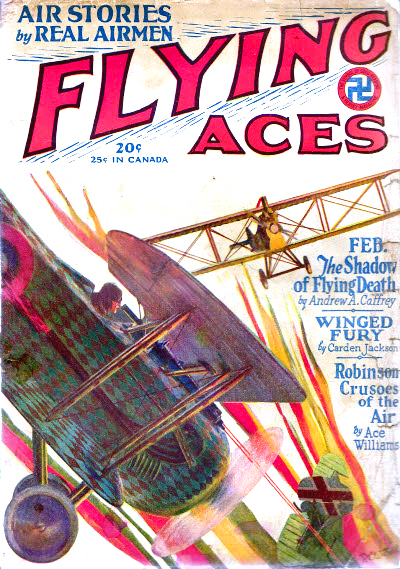 another story by Franklin M. Ritchie. Ritchie only wrote aviation yarns and his entire output—roughly three dozen stories—was between 1927 and 1930. Today we have another one from the lawyer who wrote pulp stories on the side to satisfy his yen for flying. From an early issue of Flying Aces, Ritchie gives us a tale of bomber Jim Barker who longed to show everyone that even a bombing pilot can get Germany’s most ruthless Ace, by any means necessary! From the February 1929 issue of Flying Aces, it’s Franklin M. Ritchie’s “Say It With Bombs!”
another story by Franklin M. Ritchie. Ritchie only wrote aviation yarns and his entire output—roughly three dozen stories—was between 1927 and 1930. Today we have another one from the lawyer who wrote pulp stories on the side to satisfy his yen for flying. From an early issue of Flying Aces, Ritchie gives us a tale of bomber Jim Barker who longed to show everyone that even a bombing pilot can get Germany’s most ruthless Ace, by any means necessary! From the February 1929 issue of Flying Aces, it’s Franklin M. Ritchie’s “Say It With Bombs!”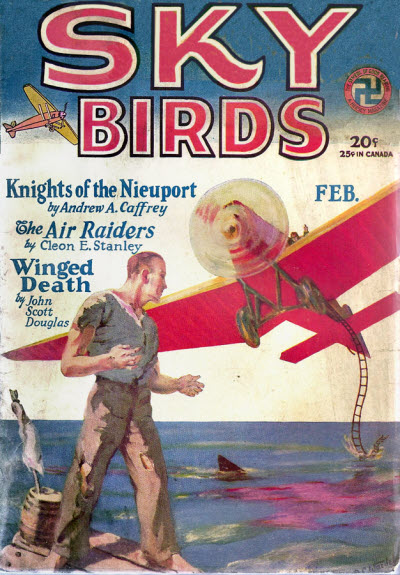 another story from one of the new flight of authors on the site this year—Andrew A. Caffrey. Caffrey, who was in the American Air Service in France during The Great War and worked for the air mail service upon his return, was a prolific author of aviation and adventure stories for both the pulps and slicks from the 1920’s through 1950. For the second issue of Sky Birds, Caffrey tells the story of Lieutenant Mike Harris—a.k.a. “Coupe Mike” due to his proclivity to overuse the coupe button during his training—fresh up from Issoudon after extensive training.
another story from one of the new flight of authors on the site this year—Andrew A. Caffrey. Caffrey, who was in the American Air Service in France during The Great War and worked for the air mail service upon his return, was a prolific author of aviation and adventure stories for both the pulps and slicks from the 1920’s through 1950. For the second issue of Sky Birds, Caffrey tells the story of Lieutenant Mike Harris—a.k.a. “Coupe Mike” due to his proclivity to overuse the coupe button during his training—fresh up from Issoudon after extensive training.
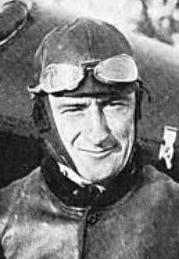 MY LONG-LOAFING experience was started back in Lawrence, Massachusetts, on the coldest March the eleventh that 1891 knew. That makes me twenty-one by actual count.
MY LONG-LOAFING experience was started back in Lawrence, Massachusetts, on the coldest March the eleventh that 1891 knew. That makes me twenty-one by actual count.
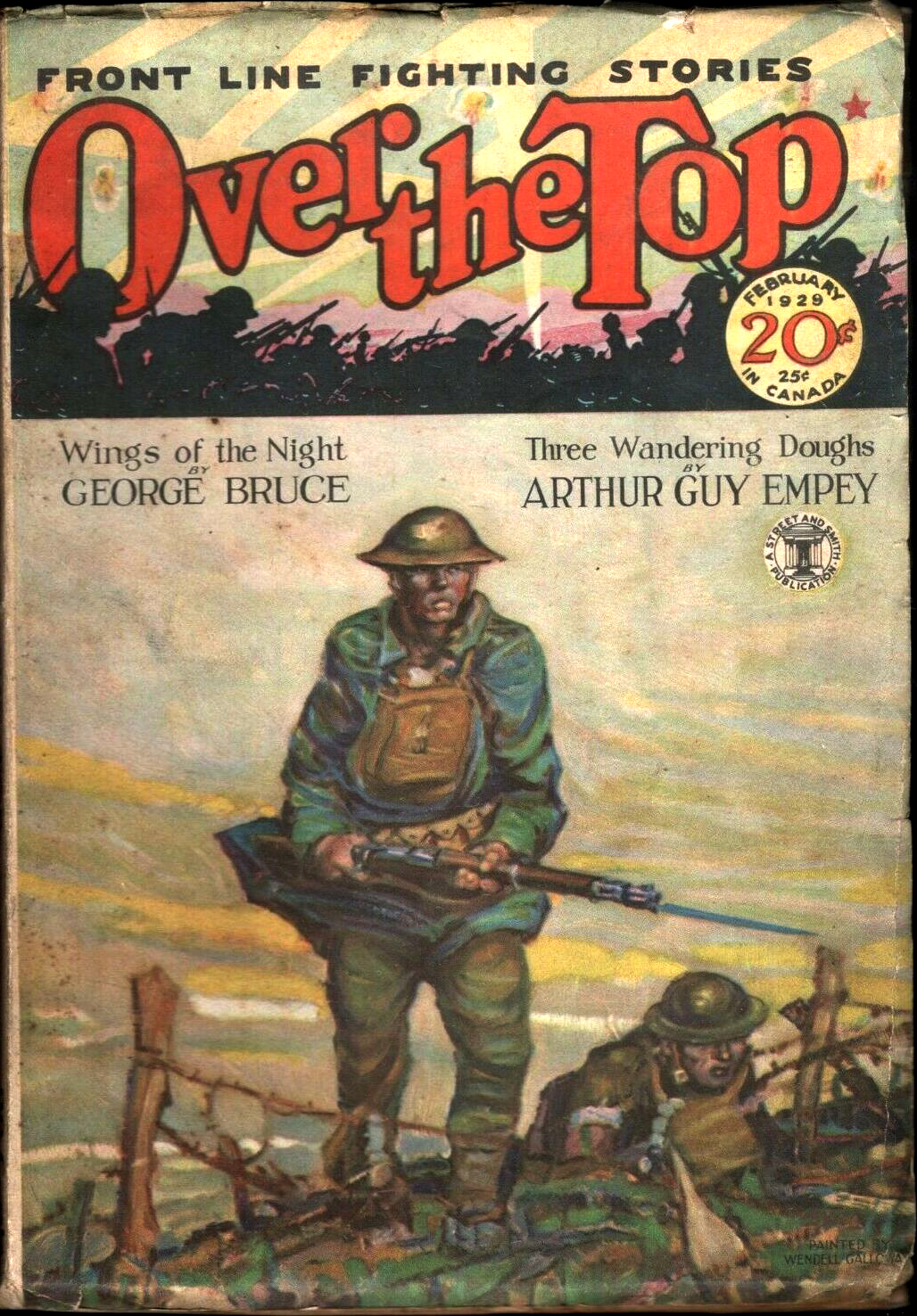 a story from
a story from  exciting air adventure with Rusty Wade from the pen of Frank Richardson Pierce. Pierce is probably best remembered for his prolific career in the Western Pulps. Writing under his own name as well as two pen names—Erle Stanly Pierce and Seth Ranger—Pierce’s career spanned fifty years and produced over 1,500 short stories, with over a thousand of these appearing in the pages of Argosy and the Saturday Evening Post.
exciting air adventure with Rusty Wade from the pen of Frank Richardson Pierce. Pierce is probably best remembered for his prolific career in the Western Pulps. Writing under his own name as well as two pen names—Erle Stanly Pierce and Seth Ranger—Pierce’s career spanned fifty years and produced over 1,500 short stories, with over a thousand of these appearing in the pages of Argosy and the Saturday Evening Post.  winter days with snow streaking through the sky, it seems right and proper to introduce Frank Richardson Pierce to you folks. Pierce lives up in the Northwest, up in Seattle, Washington—and he spends a good deal of his time hopping around Alaska. He is an outdoor man in every sense of the word. There are few writers in America who can catch the spirit of the frozen North as he can. His interests lie out under the open sky, with snow fields, fir forests, Canyons and great rivers. It was natural, therefore, that he took to flying.
winter days with snow streaking through the sky, it seems right and proper to introduce Frank Richardson Pierce to you folks. Pierce lives up in the Northwest, up in Seattle, Washington—and he spends a good deal of his time hopping around Alaska. He is an outdoor man in every sense of the word. There are few writers in America who can catch the spirit of the frozen North as he can. His interests lie out under the open sky, with snow fields, fir forests, Canyons and great rivers. It was natural, therefore, that he took to flying.
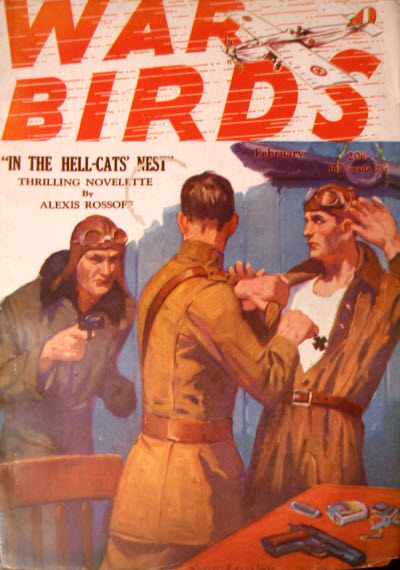 the third of three Three Mosquitoes stories we’re presenting this month. This week Kirby is hand-picked to to currier valuble war plans from Paris to Colonel Drake at his own drome. Sounds easy enough—but nothing is ever easy when there are more spys from imperial inteligence than frenchmen on the route. And Kirby is told he must either deliver the plans or make sure they are utterly destroyed if they fall into enemy hands! It’s another exciting tale of Ralph Oppenheim’s The Three Mosquitoes that originally ran in the February 1929 number of War Birds magazine!
the third of three Three Mosquitoes stories we’re presenting this month. This week Kirby is hand-picked to to currier valuble war plans from Paris to Colonel Drake at his own drome. Sounds easy enough—but nothing is ever easy when there are more spys from imperial inteligence than frenchmen on the route. And Kirby is told he must either deliver the plans or make sure they are utterly destroyed if they fall into enemy hands! It’s another exciting tale of Ralph Oppenheim’s The Three Mosquitoes that originally ran in the February 1929 number of War Birds magazine!